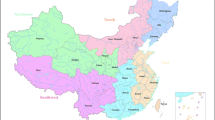Abstract
North China, whose total area is 420,000 km2, covers 2 provinces and 2 cities (Shanxi and Hebei provinces, Beijing and Tianjin) and the territories of Henan and Shandong provinces to the north of the Huanghe (Yellow) River, and part of the Inner Mongolia Autonomous Region and Liaoning Province. Most of this region, which is situated in the semi-humid, semi-arid continental climate temperate zone, gets an annual precipitation of 500–600 mm, whereas, the perennial average amount of total water resource is 50.99 billion m3, including 33.82 billion m3 of surface water, 32.94 billion m3 of ground water and 15.77 billion m3 of their duplication. Due to the intensive exploitation of water resource caused by the deficiency of water resource in North China, key elements of water balance was changed, runoff volume reduced, evaporation increased, vertical movement of moisture strengthened, water circulation pattern transformed from open system into regionally closed system; meanwhile, due to the incompetent water purification system in comparison with the wastewater discharge, the pollution of water bodies goes bad to worse. Furthermore, some water bodies becomes unusable. The reduction in runoff amount, both surface and under ground, and the pollution of water body cause a series of environmental problems. The essential contributing factors of the water resources problems in North China are the deficiency of water resource and water pollution. The deficiency was mainly caused by fast increase in water consumption and water pollution, besides the fragility of local natural conditions. The deficiency is consequently brought about by population growth and economic development incoordinate with local circumstance. The strategies to deal with the water resources problems should include the following aspects: 1) the establishment of water-saving economy and society, 2) proper management and rational utilization of water resources, 3) the exploitation of new water resources, and 4) the improvement of wastewater treatment ability.
Similar content being viewed by others
References
中国科学院地学部, 华北地区水资源合理开发利用, 水利电力出版社, 北京, 1990.
李 宝庆等, 水资源开发与环境, 科学出版社, 北京, 1990.
李 金昌, 中国资源与环境, 新华出版社, 北京, 1988.
曲 格平等, 世界环境问题的发展, 中国环境科学出版社, 北京, 1987.
唐 以剑等, 我国发展中的水环境问题与对策, 地理学报, 44 (3), 302–313, 1989.
綦文正, 日本水体污染的现状与对策, 世界环境 (2), 15–18, 1988.
Hiroshi UNE, 日本地面下沉现状与控制, 世界环境, (4), 28–31, 1988.
Williams W.D., 河流盐碱化, 国外环境科学技术, (1), 12–17, 1988.
聂璋义, 英国给排水事业概况, 国外环境科学技术(1), 1–6, 1989.
于国政, 苏联区域环境研究的进展国外环境科学技术(1), 7–11, 1989.
Fralkenmark M. et al., 二十一世纪水맜理的新战略, 世界沙漠研究, (1), 27–33, 1990.
钱 秉钧等, 芬兰, 丹麦, 法国水污染防治见闻, 环境污染与防治, 10 (6), 31–34, 1988.
郭建钦, 苏联净水技术发展现状, 国外农业环境保护, (2), 1–4, 1988.
Author information
Authors and Affiliations
Rights and permissions
About this article
Cite this article
Li, L., Li, B. The problems of water resources in North China and the strategy. Chinese Geographical Science 2, 183–196 (1992). https://doi.org/10.1007/BF02664540
Issue Date:
DOI: https://doi.org/10.1007/BF02664540




